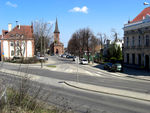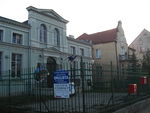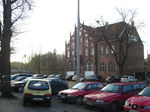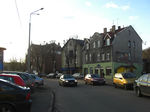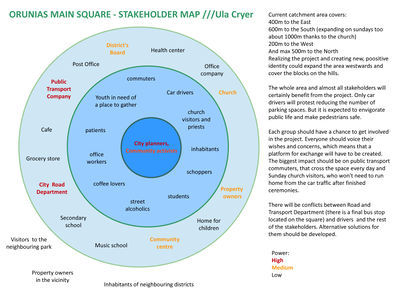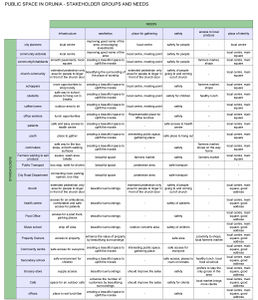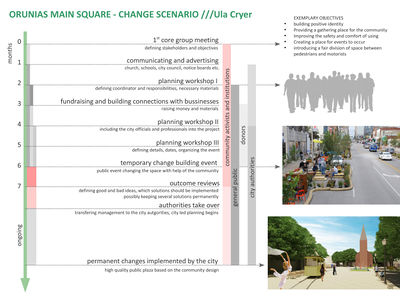Landscape Democracy 2015 Working Group B - Case Study 1
---> back to group page working group B
Public life vs. car traffic - the main square in Orunia, the historic suburb of Gdańsk
| place name | main square in Orunia | |
| Location | Gdańsk Orunia | |
| Country | Poland | |
| Author(s) | Ula Cryer | |

| ||
|
| ||
Rationale: Why have you chosen this case for the landscape and democracy seminar?
Orunia has a very long history, mostly as a rich and beautiful area for out-of-town living and relaxation. Last century, however, has brought change and problems. The place has been overwhelmed and destroyed by infrastructure. First, it was cut in half by railway at the end of 18th century, than it was crossed by the main transit road as well and the area between Orunia and the center of Gdańsk was filled with warehouses and industry. Today, it still has a beautiful park and a few, forgotten, green corners, but it completely lacks quality spaces between the buildings, where people can linger and interact with one another. This is why the old main square in front of the church and other public facilities, which is now a traffic dominated area with wide roads and many parking places, should be re-transformed into a place for people on foot.
Representation of your observations
- Observations
One look into the square shows how desolate the place is. The space that is completely dominated by car traffic gives little opportunity for public life. It's dangerous for pedestrians, who crisscross the square on their way to and from the bus stops, church and other amenities. No one lingers though. People pass quickly, and in fear, often come by car, even when they live close by, because neglected pathways are bumpier than roads. Crowds spilling out of the church have no space on the pavement to stay longer, talk to friends and neighbors, so most of the people just leave quickly alone. Interestingly, there is still more people passing this space daily on foot then inside a car, but majority of space is given to those behind the wheels.
Dedication of the main public spaces in the area to automobiles causes isolation of people who once belonged to a tight community. The increase in the number of cars is constantly deepening the chasm between people.
Reflection
What are the major challenges for changing the situation?
1. Activating The Community. Over the years of futile efforts to make city officials focus on the area and improve existing public spaces, many people decided, that their voice does not count. When asked on the street, many will say it is pointless to appeal, fight and discuss with the authorities, as they will do as they like anyway. There are new social organizations trying to activate local people but decades of stagnation prove the task difficult.
2. Changing the focus from car to pedestrian traffic in the city. There are massive investments in new and old roads all around Gdansk, but hardly any in walkways and bicycle paths. Authorities must realize it is pedestrian areas that shape the good image of the city and happiness of its residents, not smooth streets that allow cars to zoom at a speed.
3. Decision makers are often reluctant to spend money on less popular parts of town. The challenge would be to show, that the first phase of the change could be implemented with little amount of funds, designating spaces with paint and mobile planters, thus testing the spatial arrangement and reaction of the community.
What could be a starting point for democratically-based change?
1. Local discussions - let residents speak out. What do they want their main square to be, what do they want to implement, what they can resign from. 2. Discussion between the community and city authorities - hear what both sides can contribute to the project. Are there points where they agree and disagree? Can they reach a consensus. 3. Field workshop - a weekend event where the community could try their ideas in the field, designating the shape of their public space with simple and cheap materials (painting the square floor in stead of paving it straight away), placing benches and mobile planters, thus checking how the place work in reality, what else do people need or what they don't like. The favorite setting would be realized in the permanent form whenever the funds for it could be secured.
Stakeholder Mapping
Create a visual representation of the stakeholder groups that are involved in your case. Try to cover the following aspects in your representation: Power (high, medium, low) / Support (positive, neutral, negative)/ Influence (high or low)/ Need (strong, medium, weak)+ also map the relationships between the stakeholder groups
- Stakeholder Map
- Stakeholder Needs
Change Scenario
The following scenario is a bottom- up one that changes into top - down over time. To supply the good information platform that would enable all types of users to voice their opinion about how the space should look and work like, I proposed creating an urban laboratory of sort. Starting with a few brainstorming workshops, fundraising and creating connections between local community, businesses and the city authorities, scenario develops into implementing temporary changes at the square. They would be done and overlooked by the locals themselves. Over a span of a month we could test how closing the whole area for the car traffic would affect the public life. It's also possible that making the streets more narrow or creating a shared space square would work just as well, or better. After the testing period the results would be transfered to the city administration, so that they could implement the permanent changes according to the wishes of the community.
- Change Scenario
Cross cutting theme
We identified two types of cross-cutting themes. The first involved all the four different cases: all the main issues in our cases are of social nature. We want to address social problems by intervening in the landscape. All of us believe that by creating inclusive, public spaces we can resolve the existing problems or at least improve the situation of local community.
Concluding reflections
I believe that involving the community on the "field of action", not only during workshops, is a very good idea, that has a capability of not only bringing the changes quicker, but also building stronger links between the people. Public events also attract more people than workshops in confined spaces. On the top of it all, testing solutions in real life and scale 1:1 gives real outcomes and shows conflicts and mistakes before big funds were spent on the project. Only risk is that the authorities may postpone the realization of the proper changes, thus making the low quality, temporary solutions permanent.
References
- The Better Block http://betterblock.org/
- http://www.communityplanning.net/
* Please make sure that you give proper references of all external resources used.
* Do not use images of which you do not hold the copyright.
* Please add internet links to other resources if necessary.
About categories: You can add more categories with this tag: "", add your categories
